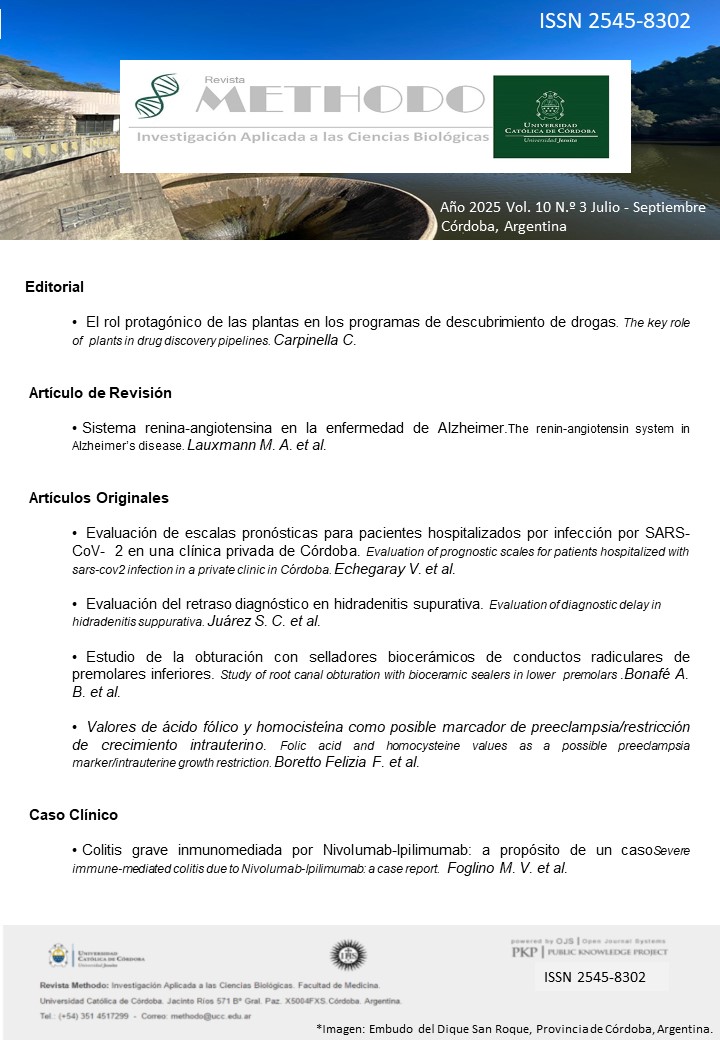Folic acid and homocysteine values as a possible preeclampsia marker/intrauterine growth restriction
DOI:
https://doi.org/10.22529/me.2025.10(3)06Keywords:
pregnancy, folic acid, homocysteine, preeclampsia, IUGRAbstract
INTRODUCTION: Folate deficiency has been associated with elevated levels of homocysteine in the blood.For its part, hyperhomocysteinemia plays a role in the mechanisms of placental vasculopathy, gestational arterial hypertension and preeclampsia. Therefore, if elevated homocysteine is a factor associated with these pathologies, folic acid supplementation could significantly reduce the risk of develop them.
OBJECTIVES: To evaluate the changes in folic acid and homocysteine values in the preconception period
and during the first trimester of pregnancy and their correlation with screening for preeclampsia and intrauterine growth retardation (IUGR). To determine the relationship between folic acid and homocysteine
values in the preconception period and obstetric outcomes such as preeclampsia and IUGR. To evaluate the association of these values in the preconception period with other adverse perinatal outcomes, such as late abortion.
MATERIAL AND METHOD: Cohort, prospective, analytical study. The population was made up of patients who attended the preconception consultation at the Reina Fabiola University Clinic in the period 2021-2024.
Demographic and clinical variables [pathological history, preconception, pre-eclampsia risk screening and
intrauterine growth retardation (IUGR) and current pregnancy, including perinatal and biochemical outcomes (preconception and first trimester of pregnancy folemia and homocysteinemia) were analyzed.
RESULTS: Data from 28 patients were analyzed. Of the total, 3 (10%) patients had hypertension, 1 (3%)
had IUGR, and 2 (7%) had abortion. The median (RIQ) of preconception folate was 16.4 (14.7-17.7) in those who presented high-risk screening and 13.3 (12-17.2) in those with low risk; 17.1 (1604-17.6) in patients with hypertension vs 14.6 (12.4-17.5) in those without; 17.7 (12.5-17.7) in those who presented IUGR vs 14.7 (12.5-17.5) in those who did not; 13.4 (12.6-14.1) in those who had an abortion vs 14.7 (12.6-17.6) in those who achieved a normal pregnancy. Preconception homocysteine values were 7.90 (7.80-8.80) in patients with high-risk screening vs 7.40 (6.72-8.80) in low-risk patients; 9.95 (9.59-10.3) in patients with hypertension vs 7.56 (6.60-7.99) in those without; of 7.60 (6.84-9.95) in the patient who presented IUGR vs 5.90 (6.84-8.78) in a normal pregnancy.
CONCLUSION: In this study, no significant difference was found regarding the values of folic acid and homocysteine with the first trimester screening. Preconception folate concentrations also did not differ in patients with hypertension, IUGR, or abortion. Although preconception homocysteinemia values were higher in patients with high-risk screening, in those who developed hypertensive states and in those who had an abortion as an outcome, a statistically significant association was found with the development of HTA.
Published
How to Cite
Issue
Section
License
Copyright (c) 2025 Methodo Investigación Aplicada a las Ciencias Biológicas

This work is licensed under a Creative Commons Attribution-NonCommercial-ShareAlike 4.0 International License.




















